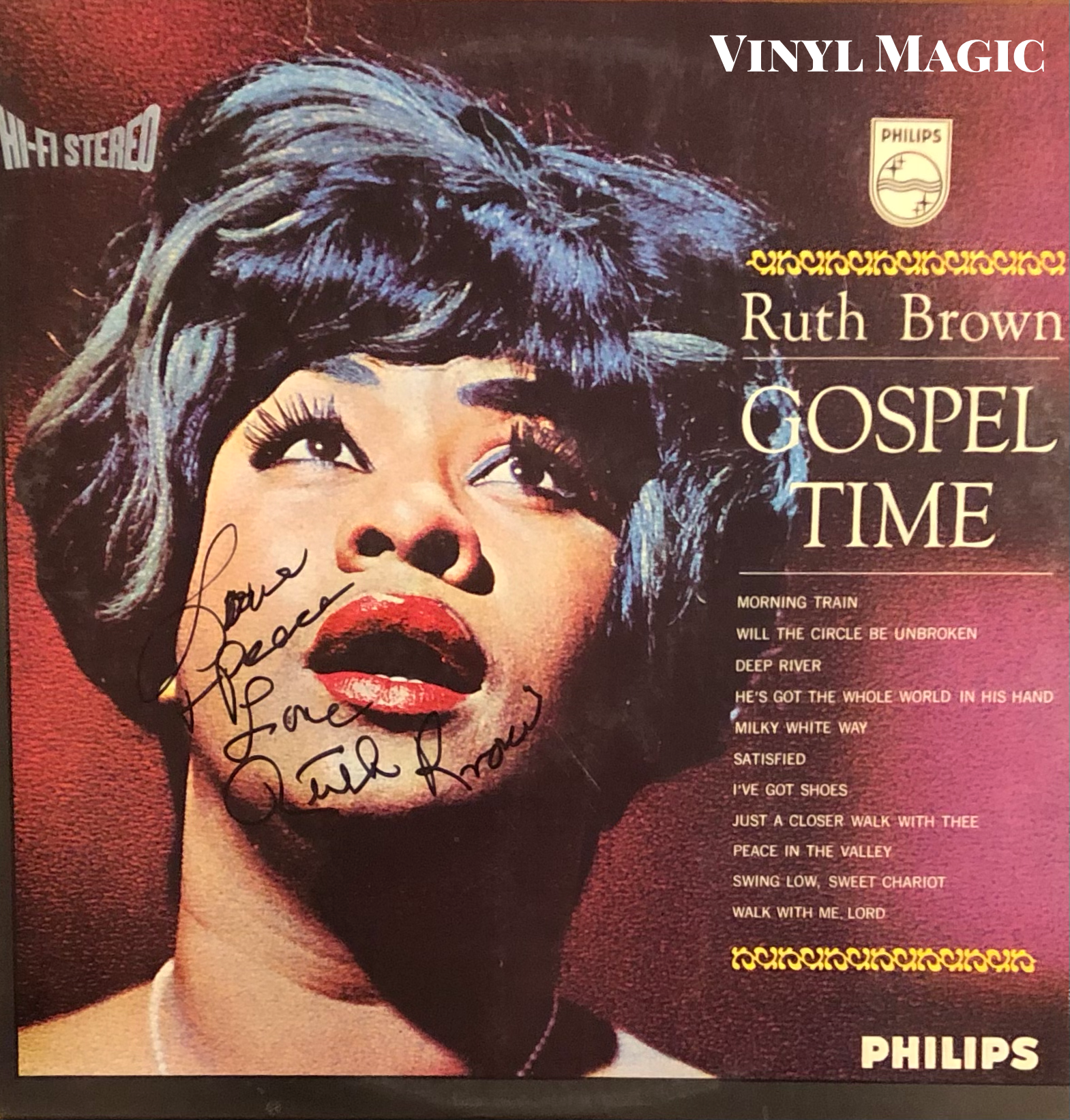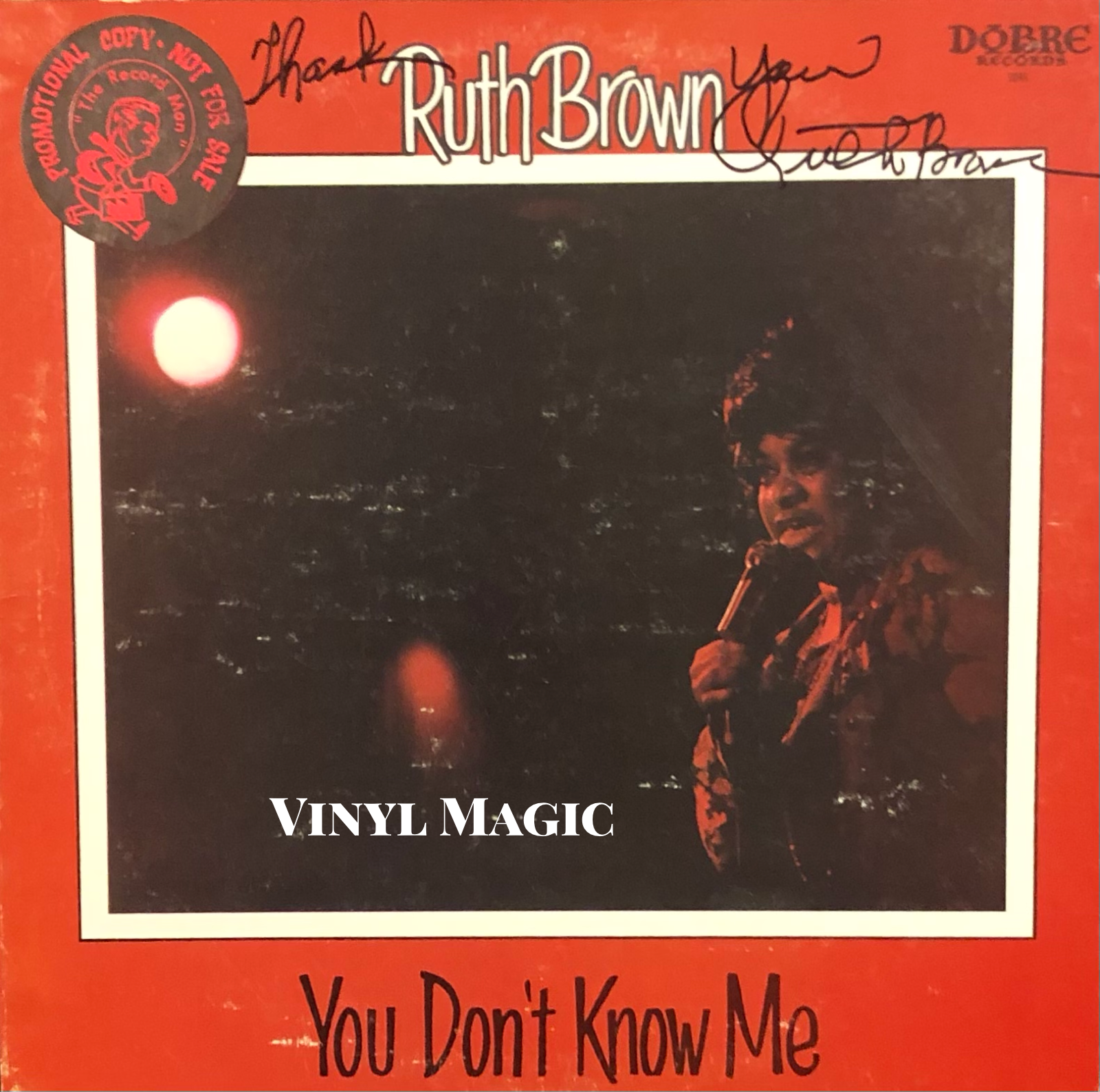Ruth Brown and Me…
She was one of the original divas. I can't really say that I've heard anyone that sounds like Ruth, before or after. She was a combination of sass and innocence, and she was extremely funky. She could really put it right on the beat, and the tone of her voice was just mighty. And she had a great heart. What I loved about her was her combination of vulnerability and resilience and fighting spirit. It was not arrogance, but she was just really not going to lay down and roll over for anyone.
Rock & Roll (1949-56recordings, released 1957) signed by Ruth
I was trying to do Billie Holiday, because she was the voice to be heard at that time... I could do her better than she could do herself. When I got into New York and I worked in Café Society, she walked in the club one night and I was onstage with a gardenia and everything in my hair. Josh White told me there was this woman in the club and she was Billie Holiday. She upset the table, stood up and walked away while I was onstage. I was insulted or hurt, I didn't know what. When I did get off, I went backstage and she was still there. She looked at me and said, 'Let me tell you something, and you better believe this: You got a great voice, and your star is out there. You can be wonderful, but you have got to know who you are. Every time that you go out on that stage and do what you did just now, they call my name. But nobody will ever know yours.'
Ruth Brown on meeting Billie Holiday
Gospel Time (1962) signed by Ruth “Love Peace Love”
In school, we had music classes, but I ducked them. They were just a little too slow. I didn't want to read no note. I knew I could sing it. I woke up one morning and I could sing.
Ruth Brown
Unfortunately, a lot of entertainers have the wrong disposition. They treat people like, 'Oh, you are so lucky, here I am.' I always take time to talk to people to tell them I appreciate them. What has made it easier for me now at this late age, is I don't remember meeting anyone who said, 'I like Ruth Brown's singing, but I can't stand that bitch, she is evil.'
Ruth Brown
Ray (Charles) called me and said, 'I'm doing this movie. Who do you want to play you?' And I said, 'Halle Berry, you crazy fool!' He said, 'I ain't that blind.'
Ruth Brown on her last conversation with Ray Charles
Ruth Brown’65 (1964) signed by Ruth
Born in Portsmouth, Virginia, Ruth Weston was steeped in the gospel harmonies of the Emanuel A.M.E. church where her father served as the choir director. She also fell under the spell of secular music, the songs and vocals of Ella Fitzgerald, Sarah Vaughan, Dinah Washington and, especially Billie Holiday. Soon, Ruth began clandestine trips across the Elizabeth River in Southern Virginia to perform in night clubs as a teenager. As Ruth recalled, "The club owners would talk to each other...that's how I got my jobs, one person would say, 'This girl is good.' And, of course, I was singing cheap." Secular music - her parents called it "the devil's music" - prevailed over sacred and Ruth ran off and married trumpet player Jimmy Brown when she was only seventeen years old. Or, at least Ruth thought she married Jimmy - he was already married - and while ol' Jimmy didn't hang around for long, the name Ruth Brown stuck.
In 1949, Ruth Brown was signed by Ahmet Ertegun and Herb Abramson, the co-founders of Atlantic Records, a fledgling rhythm and blues label which was only two years old. Ruth's first hit was "So Long" in 1949, and then "Teardrops In Your Eyes" followed in 1950 which stayed Number One on the R&B charts for three months. Ruth put Atlantic Records on the map and in the black, selling over three million records. Sixteen Top 10 and five Number One hits followed in the next six years including "5-10-15 Hours", "Oh, What A Dream", "Mambo Baby" and "Mama, He Treats Your Daughter Mean", and Atlantic Records became known as the "The House That Ruth Built." Atlantic fared very well in the ensuing years, signing Aretha Franklin, Ray Charles, Otis Redding, Led Zeppelin and The Rolling Stones, while selling and earning millions. Ruth Brown, not so much, her fortunes ebbed, and mostly ebbed some more.
The Real Ruth Brown (1972) signed by Ruth
When Ruth left Atlantic in 1960 after an eleven year stint, she was broke, not an uncommon experience for artists of that era. Through the magic of record label accounting, she was $30,00 in arrears as Atlantic accrued all her band, production, recording and travel expenses to her account which she could not pay. Worse, many of her songs were covered by popular white artists of the day with no credit, a common practice known then as "Whitewashing." I mean, does anyone really need to hear Pat Boone sing Little Richard's "Tutti Fruitti" or "Long Tall Sally"?! As Ruth ruefully related, "Well, some people might have thought it was flattering, but for me, it didn't do a damn thing except stop me from getting on the top TV shows. I never got to do The Ed Sullivan Show. Patti Page did, Georgia Gibbs did."
Ruth left the music business in the 1960s and settled on Long Island with her two young sons and husband number three, Bill Blunt, a policeman who did not want her to sing. They were not a good fit and they soon divorced. Ruth admitted, "I could pick a good song, but I sure couldn't pick a man." She raised her two sons and provided for them anyway she could: toiling obscurely as a school bus driver, teacher's assistant, and maid. No task was too menial to provide support for her family. She remembered the hard times, "Ruth the singer disappeared. I did a lot of things to survive. All I wanted was to feed my kids and keep the lights on." As her finances worsened, she reached out to her old friend at Atlantic Records, Ahmet Ertegun. She got a $1,000 check in response, a pittance, "crumbs from a rich man's label...for every Picasso he had hanging on his wall, I had a damp patch on mine", she bitterly recounted.
You Don’t Know Me (1978) signed by Ruth
Her career rebounded when an old friend, comedian Redd Foxx, invited her to appear on his show "Sanford And Son." This led to a role on a short-lived television sitcom Hello Larry, then a role in John Waters cult classic Hairspray as "Motormouth Maybelle" and eventually, a Tony award in 1989 for Best Actress in a Musical for Black And Blue. Perhaps her best achievement (and longest lasting legacy) was successfully suing Atlantic Records for royalties for her extensive back catalog. Ruth wrote in her 1995 memoir, Miss Rhythm, that despite many attempts through the years by various attorneys, she was, "expertly stonewalled by the powers at Atlantic. And always, always there was the constant threat from them: Leave, get lost, drop it, or we'll sue for the recovery of the money you owe." Ever tenacious and uncowed, Ruth found the right attorney in Howell Begle and in 1987, they won a settlement from Atlantic Records for a (paltry!) $20,000 for Ruth, forgiveness of her outstanding "debts", and an additional $1.5 million to establish The Rhythm and Blues Foundation which serves artists in need. Royalty reform was also part of the accord which benefited artists like Solomon Burke, Wilson Pickett and Big Joe Turner, and other labels like Motown, Universal Music and MCA subsequently gave sizable donations to the foundation.
The first time I saw Ruth Brown, she was performing at the Iridium in New York City in 1999 when it was located on 63rd and Broadway, near Lincoln Center. She had a great band including her long time Hammond B3 organist, Bobby Forrester, tenor saxophonist Bill Easley and music director and guitarist extraordinaire Rodney Jones. She was feisty, full of vigor, and prowled the stage like a feral cat as she sang her songs, "5-10-15 Hours", "So Long", and "Mama, He Treats Your Daughter Mean." She was particularly bawdy and bodacious on "If I Can't Sell It, I'll Keep Sitting On It", a raucous, tongue firmly planted somewhere tale of a used furniture salesman peddling wares. Full of sexual innuendo and risqué by 1936 standards when the song was written, it came from the prolific pen of lyricist Andy Razaf ("Ain't Misbehavin' " and "Honeysuckle Rose"). With Ruth's skills, it was a mesmerizing show stopper.
Gospel Time (1962) signed by Ruth “To Kendall Happy. Birthday “
Afterwards, I met with Ruth in her dressing room. She was warm and gracious as she signed the vinyl. I mentioned how much I enjoyed Gospel Time. "Well, that's where it all started for me, in the church. I love those songs," she confided. I mentioned my daughter's second birthday was coming up that weekend. "Oh, that's wonderful. What's her name?" "Kendall", I replied, and she thoughtfully signed it, "To Kendall, Happy Birthday!" The framed album still hangs proudly in Kendall's bedroom, as it has for the past seventeen years, next to some older friends, Bobby Short and Tito Puente, and newer friends, Beirut and Neutral Milk Hotel!
Erin and I saw Ruth again five years later, and though she had suffered a stroke, there was nothing that could stop her indomitable will, spirit and strength. She could no longer cavort around the stage, so she sang from her chair and the rhythm, the blues and her soul radiated. Despite all her travels and travails, there was a singular, positive affirmation in Ruth Brown and her music. Especially when she sang the blues.
The author Robert Louis Stevenson once wrote, "Life is not a matter of holding good cards, but of playing a poor hand well." No one played a hand better than Ruth Brown, rich or poor.
Have A Good Time (1988) signed by Ruth
Choice Ruth Brown Cuts (per BK's request)
https://www.youtube.com/watch?v=HnmbJruEkKw
“Mama, He Treats Your Daughter Mean" Live 1955
https://www.youtube.com/watch?v=XHe16XFQUpI
“Oh What A Dream" Live at The Apollo
https://www.youtube.com/watch?v=jhW8QqXX_ck
"Teardrops From My Eyes" Live At The Apollo
https://www.youtube.com/watch?v=hrmf5pntPXA
“Ain't Nobody's Business" Live with B.B. King 1993
https://www.youtube.com/watch?v=17LZnN20eKs
“If I Can't Sell It, I'll Keep Sittin' On It" Live 1990
https://www.youtube.com/watch?v=fADIumYD4Tw
"Mama, He Treats Your Daughter Mean" Live 1993 with Bonnie Raitt Rock n Roll Hall Of Fame Induction
https://www.youtube.com/watch?v=-CjyfQtFR2Y
"Please Send Me Someone To Love" Black Is Brown & Brown Is Beautiful 1969
https://www.youtube.com/watch?v=VA7pKn1WNwo
“Yesterday" Ruth Sings The Beatles Black Is Brown & Brown Is Beautiful 1969






